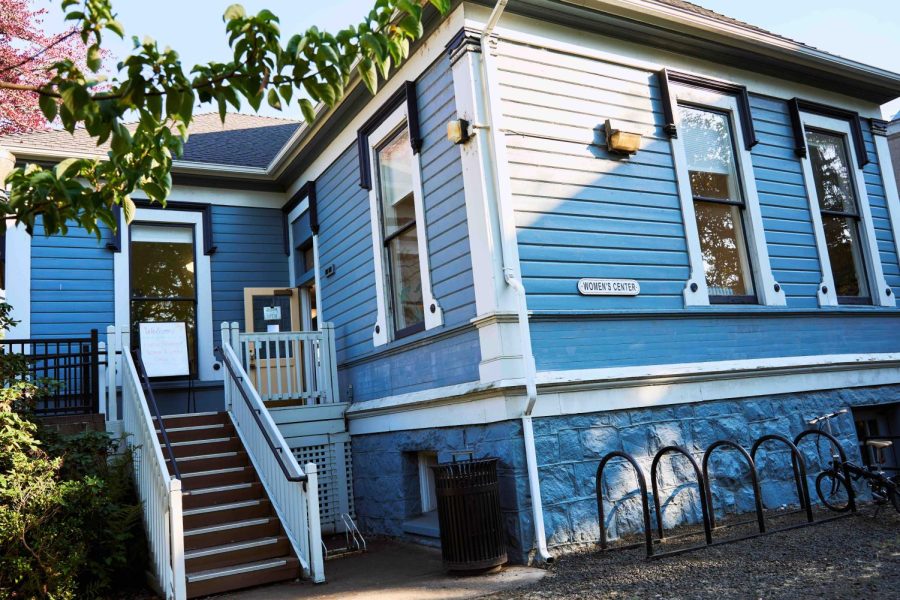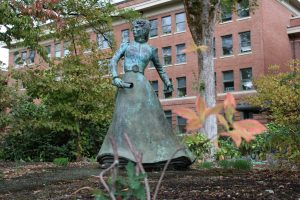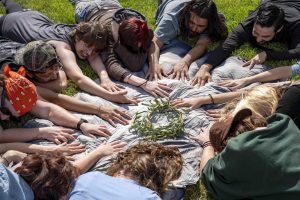‘Commitment to activism’: How a lawsuit pioneered a new OSU program, WGSS
The outside of the Hattie Redmond Center on October 5th, 2022 in Corvallis, Oregon. The center is the second oldest building on the Oregon State campus, and continues to make a difference in the community.
November 3, 2022
Oregon State University’s Hattie Redmond Women and Gender Center, formerly known as the Women’s Center, was founded in 1973, by Jeanne Dost, a women’s rights advocate and professor at Oregon State University.
After getting her Masters of Arts and Ph.D. from Harvard, working as a Havard research assistant, instructor of economics at Kansas State and then teaching graduate-level courses at the University of Washington, Dost and her husband came to OSU for jobs offered in their respective academic fields.
Jeanne was assigned to teach introductory classes as a part-time professor.
However, when a full-time position opened, the job was given to a man working on his master’s and was only offered to her after he declined. She spoke out about this treatment and was fired.
After that, she filed a lawsuit that initially lost and then was deemed as clear discrimination by the Bureau of Labor Civil Rights in an appeal of the same suit. It is believed that it was in this settlement that the Women’s Center and women’s studies program were born.
Jeanne started as both the director of the women’s center and the director of the Womens Studies Program. During her time at OSU, she continued to push for change and grew the program until it offered a graduate degree.
“The space really grew out of her own experiences of sex discrimination at OSU,” Whitney Archer said, center director for the Wome and Gender Center.
The original focus of the center according to archival research, is that it was centered on creating space for women on campus to talk about gender equality as well working to name sexism and come together to organize and affirm people’s patriarchal experiences.
This was all happening in the landscape of Title IX and other women’s rights movements around the country. The classes offered in the Women’s Studies Program centered around sexism in society and women’s oppression.
Jeanne retired in 1991 and it became clear that the program director and center director needed to be in two separate positions. In making new hires, the two programs split ways, armed with different goals.
The Women’s Studies Program, now Women Gender and Sexuality Studies program, has quickly grown to have a major, minor, master, graduate degree, queer studies minor and P.h.D. program.
The courses in these programs analyze the history and patterns of how systems of power function in order to effectively change them to better serve marginalized communities. These courses teach critical thinking skills, how to turn theory into practice and how to engage with the world differently.
“There should be value in an education for the sake of having an educated public,” said Qwo-Li Drillskill, WGSS professor.
Driskill has been at OSU for 11 years and was responsible for the creation of the queer studies minor. People with these degrees can be used all in careers working to help public good such as social work, public policy and human rights activism.
The work of WGSS students and faculty involved in other campus programs often go unnoticed, Driskill said. They pointed to how students of queer studies are prominent in the Corvallis drag scene, institutional change work, work at the cultural center, work with the Office of Equity and Inclusion and have helped shift conversations around campus.
If you look at social justice groups on campus, you’re likely to find a WGSS student, Driskill said.
“There is a commitment to activism and practice throughout this work,” Driskill said.
Despite their split in 1992, the center and the program still have a lot of ties with an ongoing commitment between the two.
“We can’t tell one story without the other,” Archer said. “The work that’s happening in WGSS classrooms directly informs what is happening in the center.”
Similar to the evolution of the program, the center has also transformed as times have changed and feminist movements have evolved. Despite the center’s aim to have diverse people working and creating there, a lot of its initial focus was on white women’s issues and working toward gender equality on campus.
However, by listening to students and paying attention to the rest of the world, the center’s goals have transformed over the years. Now, they work to center racial justice and women of color. It is home to AYA, a women of color support group, a masculinity initiative and gender-inclusive work.
“The women’s center title no longer matches the work we were doing,” Archer said. The needs this center has met continue to evolve. The center has offered counseling services for people who’ve experienced rape and sexual assault.
Archer said they still provide support to survivors and will help refer survivors to the right resources.
“It is a place of validation and affirmation,” Archer said.
Since its start, the center has worked to meet a need on campus by being a safe space for students to get support, find community and create change across campus.
Many initiatives have used the space to better the community. For example, the Pride Center started out of the center in what is now their library.
Students have led the charge in the center’s evolution over time and most recently this summer the student employees spent time working on creating a new list of values that accurately align with the current center’s mission. They decided upon:
- Community
- Advocacy
- Growth
Student employee Hazel Currley O’Malley said her favorite part of working in the center is being able to work in a socially active environment and be in connection with the other cultural centers that share that same feel.
“The sense of belonging people have found here over the years doesn’t fit in an annual report,” Archer said.






